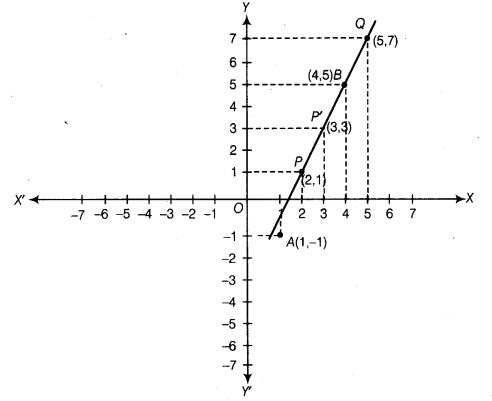NCERT Exemplar Class 9 Maths Chapter 3 Coordinate Geometry
NCERT Exemplar Class 9 Maths Chapter 3 Exercise 3.1
Write the correct answer in each of the following:
Question 1.
Point (- 3, 5) lies in the
(A) first quadrant
(B) second quadrant
(C) third quadrant
(D) fourth quadrant
Solution:
(B)
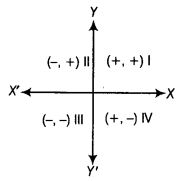
In point (- 3, 5), x-coordinate is negative and y-coordinate is positive. Therefore, the point lies in the second quadrant.
Question 2.
Signs of abscissa and ordinate of a point in the second quadrant are respectively
(A) +, +
(B) -, –
(C) -, +
(D) +, –
Solution:
(C) : In second quadrant, x-axis is negative and y-axis is positive. Therefore, x-coordinate or sign of abscissa of a point is and y-coordinate or sign of ordinate of a point is ‘+’.
Question 3.
Point (0, – 7) lies
(A) on the X-axis
(B) in the second quadrant
(C) on the Y-axis
(D) in the fourth quadrant
Solution:
(C) : In point (0, -7), x-coordinate is zero, so it lies on y-axis and y-coordinate is negative, therefore the point (0, – 7) lies on the y-axis in the negative direction.
Question 4.
Point(-10, 0) lies
(A) on the negative direction of the x-axis
(B) on the negative direction of the y-axis
(C) in the third quadrant
(D) in the fourth quadrant
Solution:
(A) : In point (- 10, 0), y-coordinate is zero and its x-coordinate is negative, therefore the point (-10, 0) lies on the x-axis in the negative direction.
Question 5.
Abscissa of all the points on the x-axis is
(A) 0
(B) 1
(C) 2
(D) any number
Solution:
(D): Since x-axis is a number line which contains many real numbers on it. So, abscissa of all the points on the x-axis is any number.
Question 6.
Ordinate of all points on the x-axis is
(A) 0
(B) 1
(C) -1
(D) any number
Solution:
(A) : Ordinate (or y-coordinate) of a point is perpendicular distance of point from the x-axis measured along the y-axis.
If point lies on x-axis, then the perpendicular distance of point from x-axis will be zero, therefore ordinate will be zero.
Thus, ordinate of all points on the x-axis is zero.
Question 7.
The point at which the two coordinate axes meet is called the
(A) abscissa
(B) ordinate
(C) origin
(D) quadrant
Solution:
(C) : The point at which the two coordinate axes meet is called the origin, y
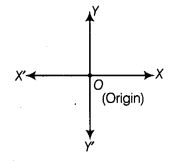
Question 8.
A point both of whose coordinates are negative will lie in
(A) I quadrant
(B) II quadrant
(C) III quadrant
(d) IV quadrant
Solution:
(C) : In III quadrant, x-coordinate and y-coordinate both are negative.
∴ A point both of whose coordinates are negative will lie in III quadrant.
Question 9.
Points (1, – 1), (2, – 2), (4, – 5), (- 3, – 4)
(A) lie in II quadrant
(B) lie in III quadrant
(C) lie in IV quadrant
(D) do not lie in the same quadrant
Solution:
(D): In points (1, -1), (2, – 2) and (4, – 5), x-coordinate is positive and y-coordinate is negative. Therefore, they all lie in IV quadrant.
But in point (- 3, – 4), x-coordinate is negative and y-coordinate is negative. So, it lies in III quadrant. Hence, given points do not lie in the same quadrant.
Question 10.
If y coordinate of a point is zero, then this point always lies
(A) in I quadrant
(B) in II quadrant
(C) on x-axis
(D) on y-axis
Solution:
(C) : Perpendicular distance of the point from x-axis measured along y-axis is zero. Distance of y-coordinate of a point is zero, then this point always lies on x-axis.
Question 11.
The points (- 5,2) and (2, – 5) lie in the
(A) same quadrant
(B) II and III quadrants, respectively
(C) II and IV quadrants, respectively
(D) IV and II quadrants, respectively
Solution:
(C) : In point (-5, 2), x-coordinate is negative and y-coordinate is positive, therefore it lies in II quadrant. In point (2, -5), x-coordinate is positive and y-coordinate is negative, therefore it lies in IV quadrant.
Question 12.
If the perpendicular distance of a point P from the x-axis is 5 units and the foot of the perpendicular lies on the negative direction of x-axis, then the point P has
(A) x coordinate = -5
(B) y coordinate = 5 only
(C) y coordinate = -5 only
(D) y coordinate = 5 or – 5
Solution:
(D) : As we know, the perpendicular distance of a point from the x-axis gives y-coordinate of that point. Since, foot of perpendicular lies on the negative direction of x-axis, therefore perpendicular distance can be measured in II or III quadrant. Hence, the point P has y-coordinate = 5 or – 5.
Question 13.
On plotting the points 0(0, 0), A(3, 0), 6(3, 4), C(0,4) and joining OA, AB, BC and CO. Which of the following figure is obtained?
(A) Square
(B) Rectangle
(C) Trapezium
(D) Rhombus
Solution:
(B) : Given, point 0(0, 0) is the origin. A(3, 0) lies on positive direction of x-axis, B(3, 4) lies in 1st quadrant and C(0, 4) lies on positive direction of y-axis. On joining OA, AB,
BC and CO, the figure obtained is a rectangle, which is shown as follows:
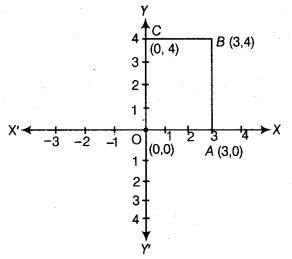
Question 14.
If P(-1, 1), Q(3, – 4), R(1, -1), S(-2, -3) and T(-4, 4) are plotted on the graph paper, then the point(s) in the fourth quadrant is/are
(A) P and T
(B) Q and R
(C) Only S
(D) P and R
Solution:
(B) : Plotting of the points P(-1, 1), Q (3, – 4), R(l, -1), S(-2, -3) and T(- 4, 4), on the graph paper is shown as follows:
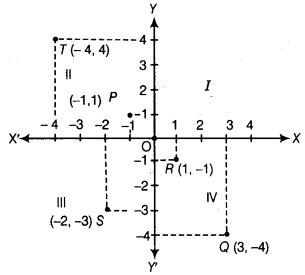
From the graph, we conclude that points R and Q lie in fourth quadrant.
Question 15.
If the coordinates of the two points are P(-2, 3) and Q(- 3, 5), then (Abscissa of P) – (Abscissa of Q) is (A) -5
(B) 1
(C) -1
(D) -2
Solution:
(B): Given, points P(-2, 3) and Q(-3, 5).
Since, abscissa of P i.e., x-coordinate of P is -2 and abscissa of Q i.e., x-coordinate of Q is -3.
Abscissa of P – Abscissa of Q = -2 – (-3)
= -2 + 3 = 1.
Question 16.
If P(5, 1), Q(8, 0), R(0, 4), S(0, 5) and O(0, 0) are plotted on the graph paper, then the point(s) on the x-axis is/are
(A) P and R
(B) R and S
(C) Only Q
(D) Q and O
Solution:
(D):
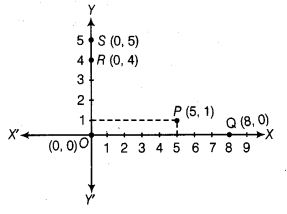
From the graph, we conclude that points Q and O lie on the x-axis.
Question 17.
Abscissa of a point is positive in
(A) I and II quadrants
(B) I and IV quadrants
(C) I quadrant only
(D) II quadrant only
Solution:
(B) : Abscissa of a point is positive in I and IV quadrants.
Question 18.
The points whose abscissa and ordinate have different signs will lie in
(A) I and II quadrants
(B) II and III quadrants
(C) I and III quadrants
(D) II and IV quadrants
Solution:
(D):
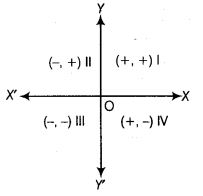
The points whose abscissa and ordinate have different signs will be of the form (—x, y) or (x, -y). These points will lie in II and IV quadrants.
Question 19.
In following figure, coordinates of P are

(A) (-4, 2)
(B) (-2, 4)
(C) (4, -2)
(D) (2, -4)
Solution:
(B) : It is clear from the figure that, given point P lies in II quadrant, so its abscissa will be negative and ordinate will be positive. Also, its perpendicular distance from x-axis is 4, so y-coordinate of P is 4 and its perpendicular distance from y-axis is 2, so x-coordinate is -2. Therefore, coordinates of P are (-2, 4).
Question 20.
In following figure, the point identified by the coordinates (- 5, 3) is
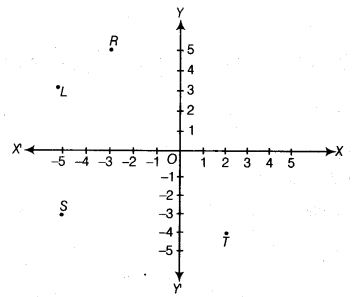
(A) T
(B) R
(C) L
(D) S
Solution:
(C) : In point (-5, 3), x-coordinate is negative and y-coordinate is positive, therefore it will lie in II quadrant. Also, perpendicular distance of L from y-axis is 5 and from x-axis is 3. Hence, the required point is L.
Question 21.
The point whose ordinate is 4 and which lies on y-axis is
(A) (4, 0)
(B) (0, 4)
(C) (1, 4)
(D) (4, 2)
Solution:
(B) : Given that ordinate of the point is 4 and it lies on y-axis, so its abscissa is zero. Therefore, the required point is (0,4).
Question 22.
Which of the point P(0, 3), Q(1, 0), R(0, -1), S(-5, 0) and T (1, 2) do not lie on the x-axis?
(A) P and R only
(B) Q and S only
(C) P, R and T
(D) Q, S and 7
Solution:
(C): As we know, if a point is of the form (x, 0) i.e., its y-coordinate is zero, then it will lie on x-axis otherwise not. Here, y-coordinates of points P(0, 3), R(0, – 1) and T(1, 2) are not zero, so these points do not lie on the x-axis.
Question 23.
The point which lies on y-axis at a distance of 5 units in the negative direction of y-axis is
(A) (0, 5)
(B) (5, 0)
(C) (0, -5)
(D) (-5, 0)
Solution:
(C): Since the point lies on y-axis, therefore its x-coordinate is zero. Also, it is at a distance of 5 units in negative direction of y-axis, so its y-coordinate is negative. Therefore, the required point is (0, – 5).
Question 24.
The perpendicular distance of the point P(3, 4) from the y-axis is
(A) 3
(B) 4
(C) 5
(D) 7
Solution:
(A): Since, abscissa or the x-coordinate of a point is its perpendicular distance from the y-axis. Therefore, perpendicular distance of the point P(3, 4) from y-axis is 3.
NCERT Exemplar Class 9 Maths Chapter 3 Exercise 3.2
Question 1.
Write whether the following statements are True or False? Justify your answer.
(i) Point (3, 0) lies in the first quadrant.
(ii) Points (1, -1) and (-1, 1) lie in the same quadrant.
(iii) The coordinates of a point whose ordinate is \(-\frac{1}{2}\) and abscissa is 1 are \(\left(-\frac{1}{2}, 1\right)\)
(iv) A point lies on y-axis at a distance of 2 units from the x-axis. Its coordinates are (2, 0).
(v) (-1, 7) is a point in the II quadrant.
Solution:
(i) False
Since the ordinate of the point (3, 0) is zero. Therefore, the point lies on x-axis.
(ii) False
Because in point (1, -1), x-coordinate is positive and y-coordinate is negative, therefore it lies in IV quadrant and in (-1, 1), x-coordinate is negative and y- coordinate is positive, therefore it lies in II quadrant.
(iii) False
Since abscissa is 1 and ordinate is \(\frac{-1}{2}\) then coordinates of a point are \(\left(1, \frac{-1}{2}\right)\)
(iv) Flase
Because point (2, 0) lies on x-axis whose distance from y-axis is 2 units.
(v) True
Because in a point (-1, 7), abscissa is negative and ordinate is positive.
Therefore it lies in the II quadrant.
NCERT Exemplar Class 9 Maths Chapter 3 Exercise 3.3
Question 1.
Write the coordinates of each of the points P, Q, R, S, T and O from the given figure:
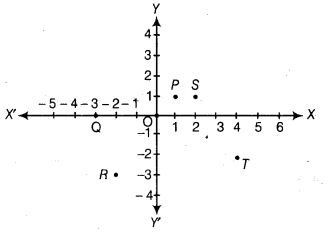
Solution:
Since, points P and S lie in I quadrant so their x and y coordinates will be positive. Now, perpendicular distance of P from both axes is 1, so coordinates of P are (1, 1). Also, perpendicular distance of S from x-axis is 1 and from y-axis is 2, so coordinates of S are (2, 1).
Point Q lies on x-axis in negative direction so its y-coordinate will be zero and x-coordinate will be -3, therefore, coordinates of Q are (-3,0).
Now, point R lies in III quadrant, so its both coordinates will be negative. Also, its perpendicular distance from x-axis is 3 and from y-axis is 2, so coordinates of point R are (-2, -3).
Point T lies in IV quadrant, so its x-coordinate will be positive and y-coordinate will be negative. Now, its perpendicular distance from x-axis is 2 and from y-axis is 4, so coordinates of T are (4, -2). Point O is the intersection of both axes, so it is the origin and its coordinates are O (0, 0).
Question 2.
Plot the following points and write the name of the figure obtained by joining them in order: P(- 3, 2), Q(- 7, – 3), R(6, – 3), S(2,2).
Solution:
Let X’ OX and Y’ OY be the coordinate axes and mark points on it. Given, point P(-3, 2) lies in II quadrant, Q(-7, -3) lies in III quadrant, R(6, – 3) lies in IV quadrant and S(2, 2) lies in I quadrant. Plotting the points on the graph paper, which is shown as follows:
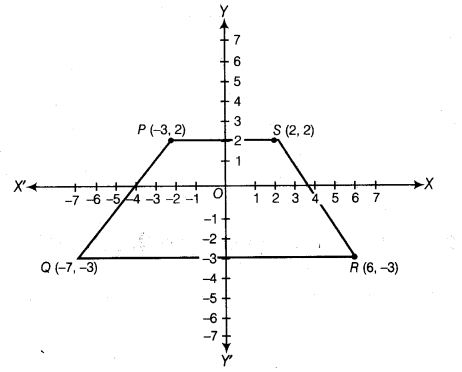
The figure obtained is trapezium PQRS.
Question 3.
Plot the points (x, y) given by the following table.
| x | 2 | 4 | -3 | -2 | 3 | 0 |
| y | 4 | 2 | 0 | 5 | -3 | 0 |
Solution:
According to given question, we have to plot the points (2, 4), (4, 2), (-3, 0), (-2, 5), (3, – 3) and (0, 0) on graph, which is shown as follows:
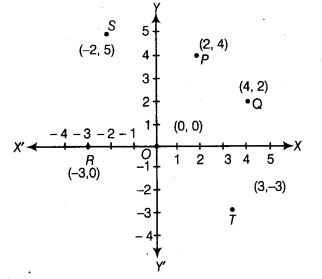
Question 4.
Plot the following points and check whether they are collinear or not:
(i) (1, 3), (-1, -1), (-2, -3)
(ii) (1, 1), (2, -3), (-1, -2)
(iii) (0, 0), (2, 2), (5, 5)
Solution:
(i) Plotting the points (1,3), (-1, -1) and (-2, -3) on the graph paper and joining these points, we get a straight line. So, given points are collinear as shown in graph below:
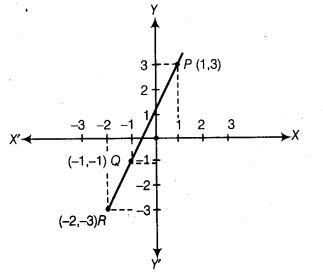
(ii) Plotting the points (1, 1), (2, -3) and (-1, -2) on the graph paper and joining these three points, we get three lines i.e., the given points do not lie on the same line. Hence, given points are not collinear as shown in graph below :
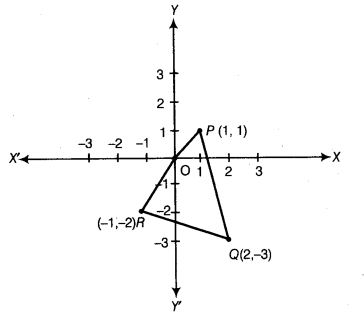
(iii) Plotting the points (0, 0), (2, 2) and (5, 5) on the graph paper and joining these points, we get a straight line. So, given points are collinear as shown in graph below
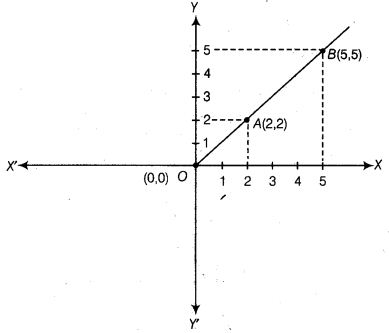
Question 5.
Without plotting the points indicate the quadrant in which they will lie, if
(i) ordinate is 5 and abscissa is – 3
(ii) abscissa is r 5 and ordinate is T 3
(iii) abscissa is – 5 and ordinate is 3
(iv) ordinate is 5 and abscissa is 3
Solution:
(i) The given point is (-3, 5). Since, abscissa is negative and ordinate is positive, therefore it lies in II quadrant.
(ii) The given point is (-5, -3). Since abscissa and ordinate both are negative, therefore, it lies in III quadrant.
(iii) The given point is (-5, 3). Since, abscissa is negative and ordinate is positive, therefore it lies in II quadrant.
(iv) The given point is (3, 5). Since, abscissa and ordinate both are positive, so it lies in I quadrant.
Question 6.
In the given figure, LM is a line parallel to the y-axis at a distance of 3 units.
(i) What are the coordinates of the points P, R and Q?
(ii) What is the difference between the abscissa of the points L and M?
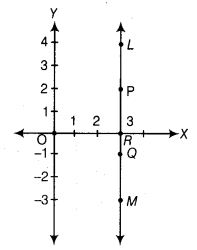
Solution:
Given, LM is a line parallel to the y-axis and its perpendicular distance from y-axis is 3 units.
(i) Coordinate of point P = (3, 2) [since, its perpendicular distance from x-axis is 2] Coordinate of point Q = (3, -1) [since, its perpendicular distance from x-axis is 1 in negative direction of y-axis].
Coordinate of point R = (3, 0) [since it lies on x-axis, so its y-coordinate is zero].
(ii) Abscissa of point L = 3, abscissa of point M = 3
∴ Difference between the abscissa of the points L and M = 3 – 3 = 0
Question 7.
In which quadrant or on which axis each of the following points lie?
(- 3, 5), (4, – 1), (2, 0), (2, 2), (- 3, – 6)
Solution:
(i) In point (-3, 5), x-coordinate is negative and y-coordinate is positive, so it lies in II quadrant.
(ii) In point (4, – 1), x-coordinate is positive and y-coordinate is negative, so it lies in IV quadrant.
(iii) In point (2,0), x-coordinate is positive and y-coordinate is zero, so it lies on x-axis.
(iv) In point (2, 2), x and y-coordinates both are positive, so it lies in I quadrant.
(v) In point (-3, -6), x and y-coordinates both are negative, so it lies in III quadrant.
Question 8.
Which of the following points lie on y-axis? A(1, 1), B(1, 0), C(0, 1), D(0, 0), E(0, – 1), F(- 1, 0), G(0, 5), H(- 7, 0) and I(3, 3)
Solution:
Since, x-coordinate of points C(0, 1), D(0, 0), E(0, -1) and G(0, 5) are zero. So, these points lie on y-axis. Also, D(0, 0) is the intersection point of both the axes, so it lies on y-axis as well as on x-axis.
Question 9.
Plot the points (x, y) given by the following table. Use scale 1 cm = 0.25 units.
| x | 1.25 | 0.25 | 1.5 | -1.75 |
| Y | -0.5 | 1 | 1.5 | -0.25 |
Solution:
Let X’OX and Y’ OY be the coordinate axes. Plot the given points (1.25, – 0.5), (0.25, 1), (1.5, 1.5) and (-1.75, – 0.25) on the graph paper as shown below:
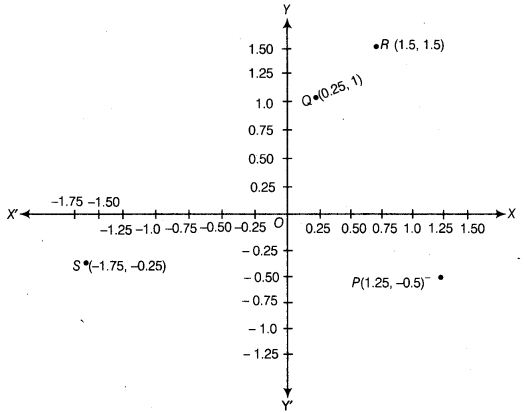
Question 10.
A point lies on the x-axis at a distance of 7 units from the y-axis. What are its coordinates? What will be the coordinates, if it lies on y-axis at a distance – 7 units from x-axis?
Solution:
Given point lies on x-axis at a distance of 7 units from the y-axis, so its coordinates are (7, 0). If it lies on y-axis and at a distance -7 units from x-axis, then its coordinates are (0, -7).

Question 11.
Find the coordinates of the point
(i) which lies on x and y-axes both.
(ii) whose ordinate is – 4 and which lies on y-axis.
(iii) whose abscissa is 5 and which lies on x-axis.
Solution:
(i) The point which lies on both x and y-axes is origin whose coordinates are (0, 0).
(ii) The point whose ordinate is -4 and which lies on y-axis is (0, – 4).
(iii) The point whose abscissa is 5 and which lies on x-axis is (5, 0).
Question 12.
Taking 0.5 cm as 1 unit plot the following points on the graph paper: A(1, 3), B(- 3, -1), C(1, – 4), D(-2, 3), E(0, -8), F(1, 0).
Solution:
Here, in point A(1, 3) both x and y-coordinates are positive, so it lies in I quadrant. In point B(-3, -1), both x and y-coordinates are negative, so it lies in III quadrant. In point C(1, -4), x-coordinate is positive and y-coordinate is negative, so it lies in IV quadrant. In point D(-2, 3), x-coordinate is negative and y-coordinate is positive, so it lies in II quadrant. Point E(0, -8) lies on negative y-axis and point F(1, 0) lies on positive x-axis. On plotting the given points, we get the following graph:
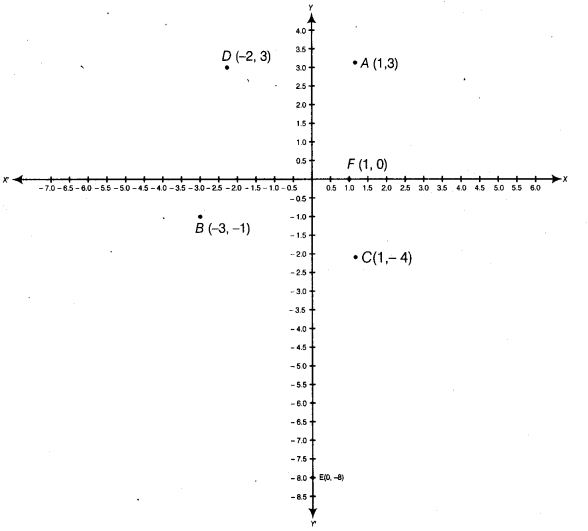
NCERT Exemplar Class 9 Maths Chapter 3 Exercise 3.4
Question 1.
Points A(5, 3), B(-2, 3) and O(5, – 4) are three vertices of a square ABCD. Plot these points on a graph paper and hence find the coordinates of the vertex C.
Solution:
The graph obtained by plotting the points A, B, C and D is given below. Take a point C on the graph such that ABCD is a square i.e., all sides AB, BC, CD and DA are equal.
Hence, abscissa of C should be equal to abscissa of B i.e., -2 and ordinate of C should be equal to ordinate of D i.e., -4. Therefore, the coordinates of C are (-2, -4).
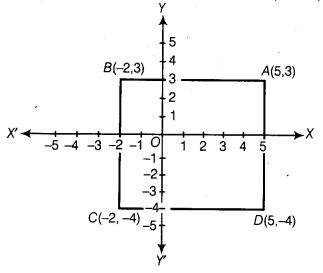
Question 2.
Write the coordinates of the vertices of a rectangle whose length and breadth are 5 and 3 units respectively, one vertex at the origin, the longer side lies on the x-axis and one of the vertices lies in the third quadrant.
Solution:
We have, length of a rectangle = 5 units and breadth of rectangle – 3 units
One vertex is at origin i.e., (0, 0) and one of the other vertices lies in III quadrant. So, the length of the rectangle is 5 units in the negative direction of x-axis and then vertex is A(-5, 0). Also, the breadth of the rectangle is 3 units in the negative direction of y-axis and then other vertex is C(0, -3). The fourth vertex B is (-5, -3).
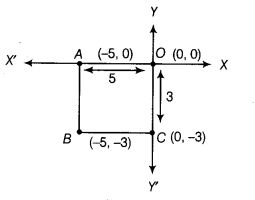
Question 3.
Plot the points P(1, 0), Q(4, 0) and S(1, 3). Find the coordinates of the point R such that PQRS is a square.
Solution:
In both points P(1, 0) and Q(4, 0), y-coordinate is zero so they lie on x-axis. In point S(1, 3), both coordinates are positive, so it lies in I quadrant.
Now take a point R on the graph such that PQRS is a square. Then, all sides will be equal i.e., PQ = QR = RS = PS. So, abscissa of R should be equal to abscissa of Q i.e., 4 and ordinate of R should be equal to ordinate of S i.e., 3. Hence, the coordinates of R are (4, 3). On plotting these points, we get the graph as shown below:
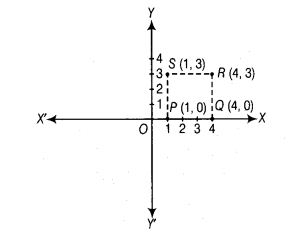
Question 4.
From the given figure, answer the following:
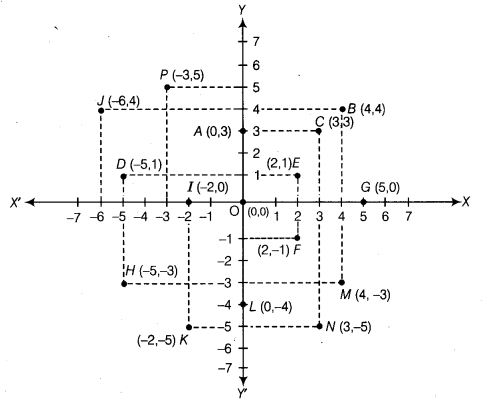
(i) Write the points whose abscissa is 0.
(ii) Write the points whose ordinate is 0.
(iii) Write the points whose abscissa is – 5.
Solution:
(i) As we know, the point whose abscissa is 0 will lie on y-axis. So, the required points whose abscissa is 0 are A, L and O.
(ii) Since, the point whose ordinate is 0 will lie on x-axis. Therefore, the required points, whose ordinate is 0 are G, I and O.
(iii) Here, points with abscissa -5 will lie in II and III quadrants. So, the required points whose abscissa is -5, are D and H.
Question 5.
Plot the points A(1, – 1) and B(4, 5).
(i) Draw the line segment joining these points. Write the coordinates of a point on this line segment between the points A and B.
(ii) Extend this line segment and write the coordinates of a point on this line which lies outside the line segment AB.
Solution:
In point A(1, -1), x-coordinate is positive and y-coordinate is negative, so it lies in IV quadrant. In point B(4, 5), both coordinates are positive, so it lies in I quadrant. On plotting these points, joining the points A and B, we get the line segment AB. Now, to find the coordinates of a point on this line segment between A and B, draw a perpendicular to x-axis from x = 2 and 3.
Let it intersect line segment AB at P and P’. Also, draw a perpendicular to y-axis from P and P’, they intersect y-axis at y = 1 and 3, respectively. Hence, we get points (2, 1) and (3, 3) which lie between line segment AB. Extend the line segment AB. Now, draw a perpendicular to x-axis from x = 5. Let it intersects extended line segment at Q. Also, draw a perpendicular to y-axis from Q and it intersects y-axis at y = 7. Hence, we get the point Q(5, 7) which lies outside the line segment AB.
